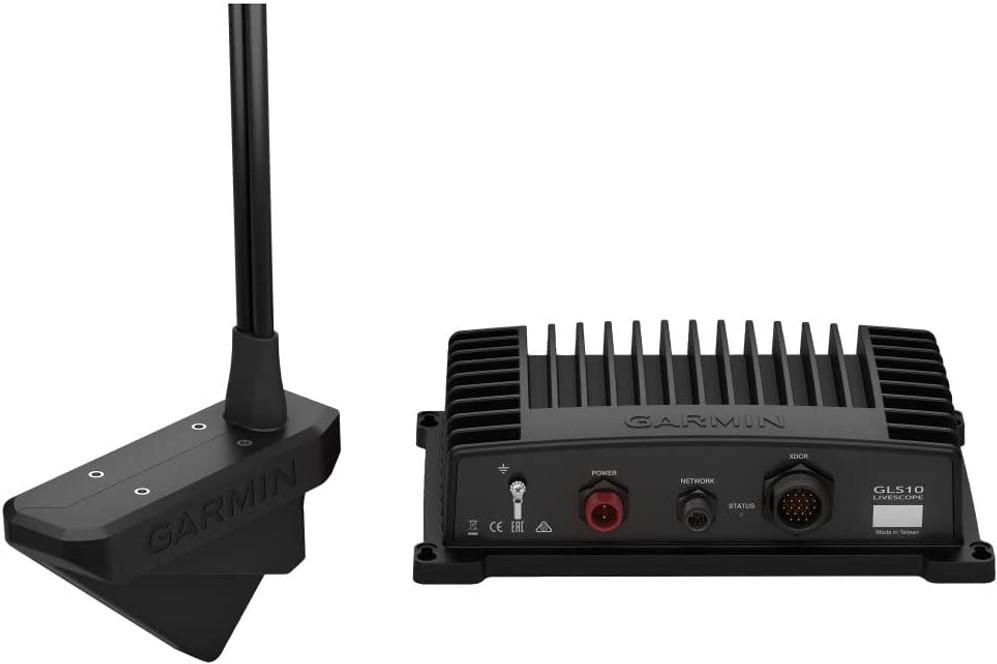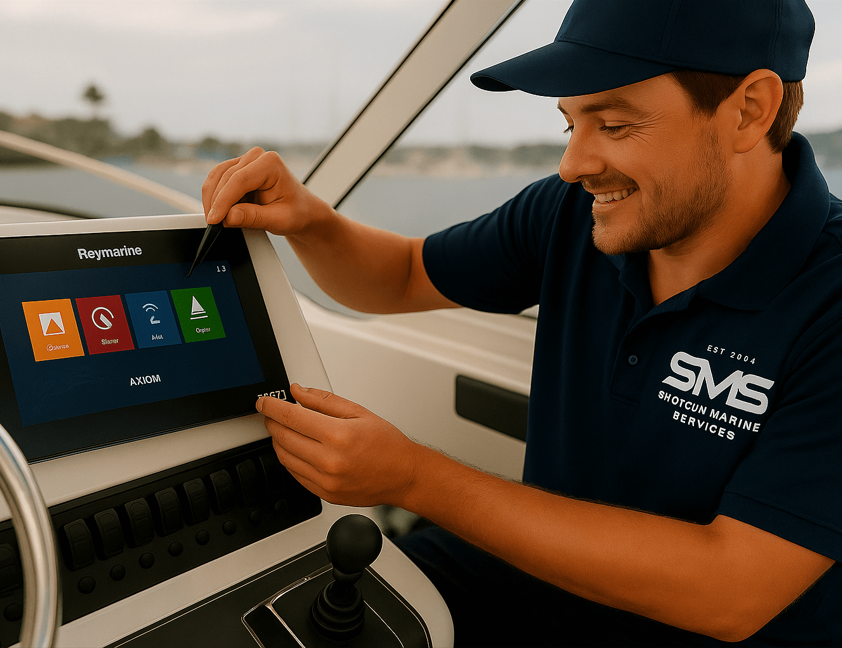Garmin LiveScope
Check out our Trial. After spending a year using the innovative sonar technology for detecting fish in front of the boat, our reviewer was truly impressed.
 The advancement of sonar technology has been nothing short of remarkable, undergoing a significant transformation since the debut of the Humminbird Super Sixty flasher in the early 1970s. This initial device, although revolutionary for its time, was cumbersome and plagued by numerous flaws and restrictions. Despite its limitations, it was nevertheless hailed by elite bass fishermen as the ultimate tool for locating fish.
The advancement of sonar technology has been nothing short of remarkable, undergoing a significant transformation since the debut of the Humminbird Super Sixty flasher in the early 1970s. This initial device, although revolutionary for its time, was cumbersome and plagued by numerous flaws and restrictions. Despite its limitations, it was nevertheless hailed by elite bass fishermen as the ultimate tool for locating fish.

If you're looking to gain the full benefits of your Panoptix LiveScope Sonar System, the Perspective Mode Mount is a necessary accessory! Simply mount on your trolling motor with the LVS32 LiveScope Transducer and scout fish and structure like never before!
In recent years, the market has been flooded with cutting-edge electronic devices specifically tailored to help fishermen chart a course through waterways and reel in more catches. For the past 12 months, I've had the opportunity to put a Garmin LiveScope to the test on my bass boat, giving me a firsthand look at the most innovative tools in bass fishing. Below, I'll share my thoughts and insights gathered from extensive real-world testing.
The innovative LiveScope system made its debut at the 2018 ICAST convention, where it took home the prestigious Best of Show honor. (Photo by Scott Bernarde)
THE LAUNCH
Garmin unveiled its groundbreaking LiveScope technology at the annual ICAST fishing industry exhibition in 2018, sweeping both the Best of Show and Best of Electronics categories. This revolutionary technology has since sent shockwaves throughout the angling community.
The groundbreaking Garmin LiveScope system made its debut at the 2018 ICAST event, taking top honors with the coveted Best of Show accolade.
Numerous individuals, both those with hands-on experience and casual onlookers, have referred to this innovation as "real-time video." Although this characterization is not entirely accurate from a technical standpoint, it effectively conveys the functionality of the LiveScope system.
My vessel is equipped with a Garmin EchoMap installed at the front of the boat, along with a LiveScope Transducer System. The sonar transducer of the Garmin EchoMap is positioned at the back of the boat, while the LiveScope transducer is attached to the trolling motor shaft using a Garmin LiveScope Perspective Mode Mount bracket.
I chose to install the LiveScope transducer on the shaft of my trolling motor, which I believe is the ideal location for a bass angler. This placement allows for unparalleled real-time visibility, enabling me to scan any area I desire simply by directing the trolling motor and transducer.
By adjusting the direction of the trolling motor and positioning the transducer to face the desired area, you can control the scope of your underwater view. To better understand this concept, imagine the LiveScope as a reversed sonar periscope, allowing you to electronically scan the underwater environment from above.
After a year of extensive use on the water, I must confess that my initial skepticism about the technology's capabilities has been proven wrong.
Not prone to following the crowd, and with a technical background, I preferred to let the technology develop and stabilize before venturing into it.
IN THE SHALLOWS
I typically fish in extremely shallow zones, with 5 or 6 feet being considered relatively deep in this region. Notably, most online videos showcasing Garmin's LiveScope features tend to focus on tracking schooling fish in open water or finding bass in deep structures like rock piles and ledges. In contrast, our approach involves searching for bass in shallow areas with shellfish, amidst aquatic vegetation, along riverbanks, and occasionally near dock pilings.
Therefore, my test in shallow water examined the unit's capability to locate fish and underwater structures that are typically not mentioned in discussions.
The Garmin LiveScope Unit has proven itself to be a game-changer, particularly in shallow water scenarios where conventional down-imaging sonar systems often fall short. The limited water depth in these applications restricts the signal's ability to disperse and provide meaningful readings, rendering traditional units largely ineffective.
Consequently, in water depths of 10 feet or less, the on-screen display provides a restricted and narrow view of the seafloor, equivalent to a thin sonar "cross-section". Although down imaging excels at providing accurate depth readings in shallow water, it is largely ineffective at detecting fish in these areas. Similarly, side-imaging technologies also have limitations in shallow water, stemming from similar constraints.
I chose to install the LiveScope transducer on the trolling motor shaft for fishing in shallow water. To do this, I used the Garmin Perspective Mode Mount, which costs around $150 bucks.
This adjustable bracket enables users to pivot the transducer 90 degrees, providing a lateral perspective of the water ahead, unlike the conventional vertical view offered by the standard mounting system.
I was blown away by the Garmin LiveScope, which revealed an entirely new dimension beneath the water's surface. With the freedom to point the sonar beam in any direction, thanks to the trolling motor's rotation, I could enjoy a live, on-screen view that was utterly invaluable. In contrast, my previous sonar experiences were limited to stagnant, 2D representations in down and side-imaging modes, offering a mere glimpse into the underwater world.
With the LiveScope, users can enjoy a real-time, 360-degree view of their surroundings, observing fish as they swim and interact with underwater features and hiding spots. The system provides remarkable clarity, often allowing users to track the movement of their lure as it descends through the water column, depending on the lure's reflective properties. This enables precise casting to specific fish that appear on the screen.
A significant benefit of LiveScope compared to traditional down or side imaging is its ability to facilitate an active search for specific features, like submerged vegetation or rocky outcroppings, while using the trolling motor. This eliminates the need to slowly and methodically sweep the boat back and forth, akin to cutting a lawn, in order to identify potential fishing hotspots.
The device can project up to 200 feet ahead. However, it's important to note that the distance it can cover depends on the depth of the water. Greater water depth allows the beam to travel farther, expanding your view area.
Even in the most minimal of depths, there is adequate visibility to provide a reliable glimpse of what's to come.
LIVECOPE FUNCTIONALITY AND COST
Using the LiveScope in forward-sonar mode is easy to understand. You can personalize the display to suit different needs, such as water depths. After setting up the unit, I didn't need to make many changes. While there is an automatic mode available, I discovered that making slight adjustments (like gain, brightness, sensitivity, etc.) in manual mode enhanced its performance.
The LiveScope System is priced at $2399.00 AUD, but there are more affordable options available like the Garmin Livescope and EchoMap UHD2 7 inch, which costs $999. This high-quality sonar and GPS unit is compatible with the LiveScope System, and discounts on the LiveScope can be found occasionally.
SO THE BIG QUESTION - Does the technology justify the cost?
The response is a definitive "yes." With LiveScope, you can detect fish that conventional sonar systems can't. This innovative technology provides a real-time, underwater view, allowing you to explore and survey the surroundings beneath the surface with unparalleled clarity.
This function significantly decreases the time you need to look for fish, which is extremely valuable for tournament anglers. It not only assists in locating fish but also in finding fish that are actively feeding. By observing fish behavior in real-time, you can determine if they are active or inactive. This feature can save you a considerable amount of time trying to catch fish that you have located using traditional sonar but are not biting. As both tournament anglers and recreational fishers understand, time spent on the water is valuable.
In recent years, technology has made tremendous strides, allowing us to accomplish feats that were previously unimaginable. For instance, who would have thought that we could observe fish swimming in real-time on a sonar display? I strongly believe that Garmin's LiveScope has revolutionized the fishing industry, offering a groundbreaking innovation that few others can match. The capability to explore the underwater environment and fish simultaneously has become an indispensable tool for anglers worldwide.
Embracing progress always comes with a price Nevertheless, individuals who prioritize cutting-edge technology and user-friendliness will appreciate the significant benefits of utilizing the Garmin LiveScope. For competitive anglers participating in tournaments, the capability to locate, observe, and ultimately hook bass instantaneously is now essential to sustaining a competitive edge.
Having used my Garmin LiveScope System for a over 12 mths it can enhance your fishing skills and help you locate more fish.
Moreover, if you frequently fish in shallow water, I highly suggest considering the Perspective Mode Bracket. This tool is incredibly beneficial, enabling you to explore areas of water that were previously unreachable with different sonar devices.
The latest innovation from Garmin is the LiveScope Plus, a cutting-edge system that takes the brand's already remarkable technology to the next level.




